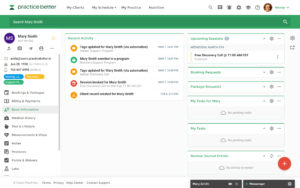Automation vs. Human Support: Finding the Right Balance in Private Practice
🕒 Updated on Last Modified Date
As a private practice owner, you’ve likely been told “automate everything!” And while automation can streamline workflows, it’s not always the full answer. On the flip side, relying too heavily on human support without smart systems can lead to burnout, inefficiency, and rising overhead.
So where’s the sweet spot?
In today’s post, we’re breaking down how to balance automation and human support in your private practice so you can work smarter—not harder—while still delivering personalized, high-quality care.
The Promise of Automation in Private Practice
Automation is a powerful tool when used strategically. It can:
✅ Reduce manual, repetitive tasks
✅ Speed up processes
✅ Minimize errors
✅ Save time and money
Examples of smart automation:
- Appointment reminders sent via text or email
- Auto-generated intake forms and consent paperwork
- EHR charting templates and macros
- Recurring invoices or subscription billing
- Email sequences for new client onboarding or re-engagement
When automation shines:
When tasks are repetitive, predictable, and don’t require a human touch. Think: sending a new client welcome email or verifying an appointment confirmation.
The Human Side: Why People Still Matter
No matter how advanced the software, automation can’t replace the empathy, problem-solving, and critical thinking that only a real person brings to the table.
This is where human support excels:
- Navigating complex insurance questions
- Responding to emotional or nuanced patient messages
- Handling scheduling conflicts or patient issues
- Following up on unpaid claims or denials
- Managing credentialing and provider relations
Human support provides the flexibility and judgment that software simply can’t replicate.
Where the Balance Can Break Down
Many private practices lean too far in one direction:
- Too much automation → patients feel like they’re talking to a robot, messages get missed, and issues fall through the cracks.
- Too much reliance on human admin → you or your team get bogged down, overwhelmed, and stuck doing things manually that could be automated.
Example: A therapist’s practice sends auto-reminders but doesn’t have a human checking if the client’s insurance is verified before their first session, leading to billing headaches later.
Or, the office is manually sending every intake form and reminder, costing hours each week that could be automated.
How to Find the Right Balance
Here’s how to combine automation and human support for maximum impact:
Automate the routine.
- Use EHR tools to send auto-reminders, forms, and follow-ups
- Set up workflows for client onboarding, surveys, or feedback
- Automate basic billing and recurring appointments
Delegate the human-first tasks.
- Hire a Virtual Medical Assistant for scheduling, lab ordering, chart prepping, or patient communication
- Have a real person review automation logs, check voicemails or chase down missing documentation
- Let a trained admin handle the back-and-forth that bots can’t finesse
Review regularly.
- Audit your systems quarterly: What can be automated? What needs a personal touch?
- Ask your team: Are we spending time on things we shouldn’t?
- Ask your patients: Is your communication clear and responsive?
Final Thoughts
You don’t have to choose between tech and team. It’s not automation vs. human support. It’s about building a system where they work together.
Think of automation as the engine, and your human support as the driver. You need both to keep your practice moving forward efficiently and with heart.
Need help finding that balance in your own practice?
That’s exactly where a Virtual Medical Assistant can help, bringing structure, empathy, and experience to your backend operations while still embracing the power of automation.
📩 Reach out if you’d like to explore how I can support your private practice with a custom workflow that blends both worlds.







